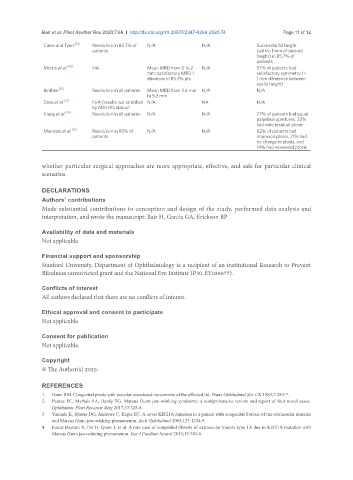Page 807 - Read Online
P. 807
Bair et al. Plast Aesthet Res 2020;7:68 I http://dx.doi.org/10.20517/2347-9264.2020.74 Page 11 of 12
Cates and Tyers [21] Resolution in 85.7% of N/A N/A Successful lid height
patients (within 1 mm of desired
height) in 85.7% of
patients
Morris et al. [34] NA Mean MRD from 0 to 2 N/A 57% of patients had
mm; satisfactory MRD-1 satisfactory symmetry (<
elevation in 85.7% pts 1 mm difference between
eyelid height)
Ibrahim [35] Resolution in all patients Mean MRD from 3.6 mm N/A N/A
to 5.3 mm
Dave et al. [22] N/A (results not stratified N/A NA N/A
by MGJWS status)
Xiang et al. [36] Resolution in all patients N/A N/A 77% of patients had equal
palpebral apertures, 23%
had mild residual ptosis
Manners et al. [37] Resolution in 93% of N/A N/A 62% of patients had
patients improved ptosis, 21% had
no change in ptosis, and
14% had worsened ptosis
whether particular surgical approaches are more appropriate, effective, and safe for particular clinical
scenarios.
DECLARATIONS
Authors’ contributions
Made substantial contributions to conception and design of the study, performed data analysis and
interpretation, and wrote the manuscript: Bair H, Garcia GA, Erickson BP
Availability of data and materials
Not applicable.
Financial support and sponsorship
Stanford University, Department of Ophthalmology is a recipient of an institutional Research to Prevent
Blindness unrestricted grant and the National Eye Institute (P30-EY026877).
Conflicts of interest
All authors declared that there are no conflicts of interest.
Ethical approval and consent to participate
Not applicable.
Consent for publication
Not applicable.
Copyright
© The Author(s) 2020.
REFERENCES
1. Gunn RM. Congenital ptosis with peculiar associated movements of the affected lid. Trans Ophthalmol Soc UK 1883;3:283-7.
2. Pearce FC, McNab AA, Hardy TG. Marcus Gunn jaw-winking syndrome: a comprehensive review and report of four novel cases.
Ophthalmic Plast Reconstr Surg 2017;33:325-8.
3. Yamada K, Hunter DG, Andrews C, Engle EC. A novel KIF21A mutation in a patient with congenital fibrosis of the extraocular muscles
and Marcus Gunn jaw-winking phenomenon. Arch Ophthalmol 2005;123:1254-9.
4. Kacar Bayram A, Per H, Quon J, et al. A rare case of congenital fibrosis of extraocular muscle type 1A due to KIF21A mutation with
Marcus Gunn jaw-winking phenomenon. Eur J Paediatr Neurol 2015;19:743-6.

